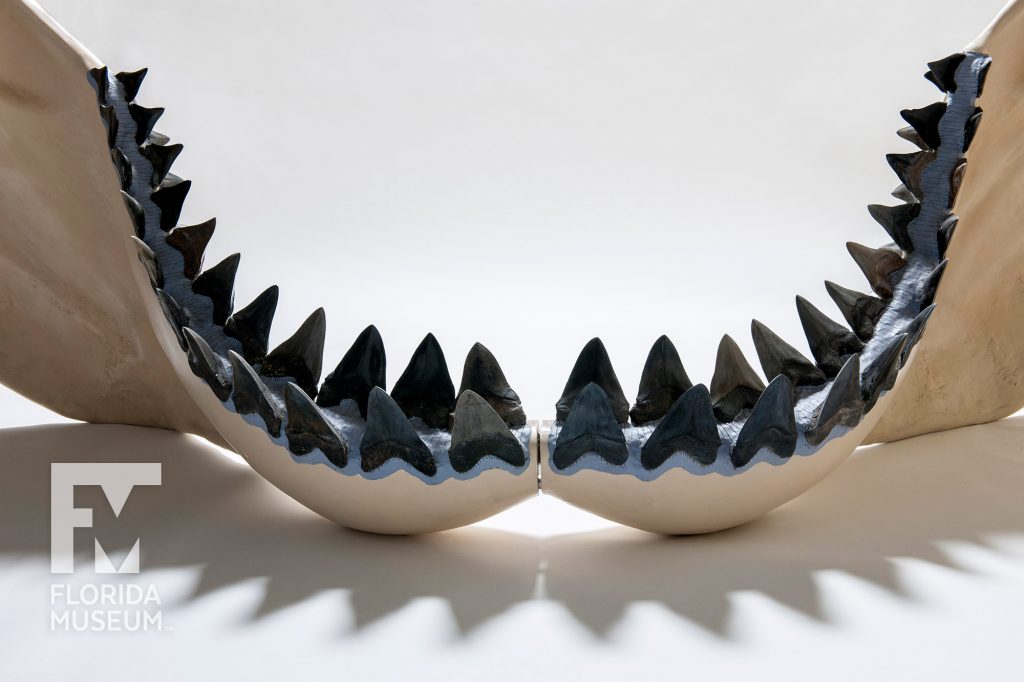Related to the modern great white and mako sharks, Megalodon was a dominant marine predator in the world’s oceans for millions of years. Museum science has contributed greatly to understanding Megalodon biology and evolution.
Summary
Megalodon Shark Jaw (Carcharodon megalodon)
From St. Johns Co., Florida
Lived ~11–5 million years ago
Collection
Story
Megalodon is really interesting because it was definitely a top apex predator in the world’s oceans between about 20 and 2 million years ago when it finally became extinct.
So for a long time there’s been a controversy among scientists, that based on the triangular shape of the tooth of Megalodon, scientists used to believe that it was similar to the triangular-shaped tooth of a modern Great White. And therefore, it was the ancestor of a modern Great White, but it was much larger. Now scientists are looking at other characteristics, like the development of the serrations on the edge of the tooth, and think that Megalodon is a cousin to the Great White and not the direct ancestor.
The growth rings in the vertebrae of the Megalodon — and other sharks as well —indicate periodic growth or deposition of the bony material within the vertebrae. You can see these seasonal bandings and they’re very much like the seasonal bandings in tree rings, so scientists can march from the middle of the backbone — the vertebrae — to the edge and count the number of these segments or these incremental growth rings and have a general estimate for how old the animal was. It doesn’t hold true all the time; sometimes if the animal’s stressed then there isn’t a growth ring, but it’s a first approximation for understanding how old the animal was, which is really cool that we can age the individual animal that lived millions of years ago.
So Megalodon is really interesting to the general public. When I go to school kids in California or Florida and I show them a Megalodon tooth, even if they’re in third grade or whatever, they know what it is — so it’s sorta like the new dinosaur of the 21st century.
Bruce MacFadden
Curator, Vertebrate Paleontology*
Distinguished Professor*
Florida Museum of Natural History
Additional Information
Read: Megalodon shark nursery discovered
Read: World’s biggest shark goes to school, thanks to 3-D printing
Watch Video: Megalodon Nursery
Exhibit
On display Sept. 23, 2017-Jan. 7, 2018, Rare, Beautiful & Fascinating: 100 Years @FloridaMuseum celebrated the Museum’s rich history. Each Museum collection was asked to contribute its most interesting items and share the stories that make them special. Though the physical exhibit is closed, this companion website remains online, providing an opportunity to experience the Florida Museum’s most treasured specimens.
Exhibit Area: Objects Tell Stories
Theme: Objects Reveal Evolution
 Want to see more? Explore more than 300 breathtaking color photos of plants, animals, fossils and cultural heritage materials from the Florida Museum of Natural History’s collections in the award-winning book All Things Beautiful available from the University Press of Florida.
Want to see more? Explore more than 300 breathtaking color photos of plants, animals, fossils and cultural heritage materials from the Florida Museum of Natural History’s collections in the award-winning book All Things Beautiful available from the University Press of Florida.
*This title was accurate at the time the exhibit was on display in 2017. Please visit the collection website to verify current staff and student information.

